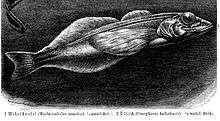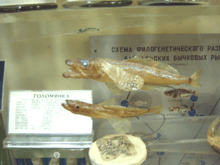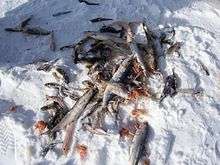Comephorus
Comephorus, known as the golomyankas or Baikal oilfish, are a genus comprising two species of peculiar, sculpin fishes endemic to Lake Baikal in Russia. Comephorus is the only genus in the family Comephoridae. Golomyankas are pelagic fishes which make the main food source of the Baikal seal.
| Comephorus | |
|---|---|
 | |
 | |
| Scientific classification | |
| Kingdom: | |
| Phylum: | |
| Class: | |
| Order: | |
| Superfamily: | |
| Family: | Comephoridae Günther, 1861 |
| Genus: | Comephorus Lacepède, 1800 |
Description
Comephorus have translucent bodies with no scales,[1] but appear dull when dead.[2] The big Baikal oilfish (C. baikalensis) can reach up to 21 cm (8.3 in) in length and the little Baikal oilfish (C. dybowskii) up to 16 cm (6.3 in).[3] Males are smaller than females, only reaching about 2⁄3 the length.[4] They have long pectoral fins, and although pelvic bones are present, they lack pelvic fins. They have a strong lateral line. The lateral line system on the head consists of large cavities linked by narrow, bony bridges with small external pores. High lipid content and porous bones result in an almost neutral buoyancy[5] and lack of swim bladder allows the fish to tolerate varying pressure extremes as they move through the water column. Over a third of the body weight (38.9%) of C. baicalensis is oil, but C. dybowski contains far less (4.7%).[6] It has been said that they decompose in sunlight, leaving behind only fatty oil and bones,[7] although the accuracy of this claim has been questioned.[2] Unusually, their eyes only contain rod cells (not cone cells), indicating a high sensitivity to light.[4] Some of the adaptions in golomyankas resemble those seen in deep sea fish.[5]
Species
There are currently two recognized species in this genus:[3]
- Comephorus baikalensis (Pallas, 1776) (Big Baikal oilfish)
- Comephorus dybowskii (Korotneff, 1904) (Little Baikal oilfish)
Biology and ecology
The common name golomyanka originates from the old-Russian golomen, meaning "far from the shore" in the local dialect and referring to their pelagic behavior.[8] They are the principal ecological competitor to the omul, which also eat small golomyankas, and represent a primary food source for the Baikal seal, at more than 90% of its diet.[2] They are easily identifiable, and are large enough to be easily seen. Golomyankas are unusual for occurring pelagically throughout the entire water column of Lake Baikal, ranging from depths of around 1.6 km (1.0 mi) to near the surface, but they primarily occur deeper than 100 m (330 ft).[9][10] During the night they move up the water column to feed, often occurring as shallow as 10–25 m (33–82 ft),[11] and in the winter they can occasionally be seen swimming just below the ice-covered surface.[12] They are considered the world's most abyssal freshwater fish, together with certain Lake Baikal deep-water sculpins (Abyssocottidae).[13] They move without much regard for changes in pressure, although they can exist only in cold temperatures, preferring water that is no more than 5 °C (41 °F) and dying at 10 °C (50 °F).[1][7]
The biomass of the golomyanka population is estimated at about 150 thousand tons, making it the most populous fish in Lake Baikal.[1][7] It is estimated that about 70% of the fish in the lake are golomyankas.[8] Their juveniles are also the most abundant pelagic fish larvae in the lake.[14] Large shoals are not known for this species, although groups of up to about 20 individuals have been recorded near the lake bottom.[2] Females are more common than males, which only make up about 32% of the population in the little Baikal oilfish and 17% in the big Baikal oilfish.[4] The females do not lay eggs; rather, they are viviparous, giving birth to a swarm of 2000–3000 larvae.[7] Females containing developing embryos can be seen year-round,[4] but there does appear to be a level of seasonality in the birth, with the largest number of larvae occurring from August to April (some differences in the peak timing between the two species).[12] Most females die after giving birth.[1] It has been claimed that their bellies burst open to release the young, killing the female in the process, but this is a myth.[2] Golomyanka can reach an age of up to 6–8 years.[1][4]
They are sluggish fish,[15] and have relatively large mouths with several rows of somewhat brush-like teeth, allowing them to sift out fine organisms from the water.[4] They primarily feed on the planktonic copepod Epischura baikalensis, the amphipod crustacean Macrohectopus branickii and larvae of sculpins,[16] including those of their own species.[8]
Relationship to humans

Despite being numerous in the lake, golomyankas are difficult to catch in large quantities as they do not occur in large schools.[2] Golomyankas are not harvested commercially, although their fats and oils were used in lamps and as traditional medicine by native Siberians when storms tossed the fish up on shore.[7] They are of no value as a food source for humans, dogs or cats, but are the primary food source for the Baikal seal, and also eaten by other fish in the lake.[2][8] They are so numerous and spawn so rapidly that they represent the largest concentration of fish biomass within the entire lake, and would seriously unbalance the ecosystem of Lake Baikal if not constantly fed upon by predators.
See also
References
- Animals and plants of Lake Baikal from Irkutsk State University, accessed May 5, 2006
- "Mysterious Fish of Lake Baikal". Science First Hand. 30 September 2004. Retrieved 31 May 2017.
- Froese, Rainer and Pauly, Daniel, eds. (2012). Species of Comephorus in FishBase. December 2012 version.
- "ГОЛОМЯНКИ, ЧАСТЬ 2: ОСОБЕННОСТИ СТРОЕНИЯ" (in Russian). Fishwatching. 29 January 2016. Retrieved 5 March 2018.
- Sideleva, V.G. (1996). Comparative character of the deep-water and inshore cottoid fishes endemic to Lake Baikal. Journal of Fish Biology 49(sA): 192–206.
- Lipids and fatty acids of two pelagic cottoid fishes (Comephorus spp.) endemic to Lake Baikal, T.A. Kozlovaa and S.V. Khotimchenko, accessed July 31, 2010
- Ichthyofauna of Lake Baikal from Baikal Web World, accessed May 5, 2006 (with a photo of the golomyanka).
- "Baikal "shark": Amazing fact about the Baikal oilfish (golomyanka)". Key to Baikal. 19 May 2017. Retrieved 31 May 2017.
- Froese, Rainer and Pauly, Daniel, eds. (2016). "Comephorus baikalensis" in FishBase. September 2016 version.
- Froese, Rainer and Pauly, Daniel, eds. (2016). "Comephorus dybowskii" in FishBase. September 2016 version.
- Burkanov, V. (2016). "Pusa sibirica". IUCN Red List of Threatened Species. 2016. Retrieved 1 June 2017.CS1 maint: ref=harv (link)
- "ГОЛОМЯНКИ, ЧАСТЬ 1: ЭКОЛОГИЯ ВИДОВ" (in Russian). Fishwatching. 21 January 2016. Retrieved 5 March 2018.
- Hunt, D. M., et al. (1997). Molecular evolution of the cottoid fish endemic to Lake Baikal deduced from nuclear DNA evidence. Molecular Phylogenetics and Evolution 8(3), 415-22.
- Dzyuba, E.V. (2006). Two coexisting species of Baikal golomyankas, Comephorus baicalensis and C. dybowski: seasonal dynamics of juveniles and their feeding. Hydrobiologia 568, Supplement 1: 111–114.
- Jakubowski, Tugarina, and Żuwała (2003). Pectoral fin development in the Baikalian viviparous golomyankas (Comephoridae; Cottoidei), with a remark on eggs and embryos of Comephorus baicalensis (Pallas). J.Anat. 203(3): 317-322.
- Miyasaka, Dzyuba, Genkai-Kato and Wada (2006). Feeding ecology of two planktonic sculpins, Comephorus baicalensis and Comephorus dybowskii (Comephoridae), in Lake Baikal. Ichthyological Research 53(4): 419-422.
- Lake Baikal FAQ Irkutsk State University Lake Baikal FAQ, accessed May 5, 2006
| Wikimedia Commons has media related to Comephorus. |